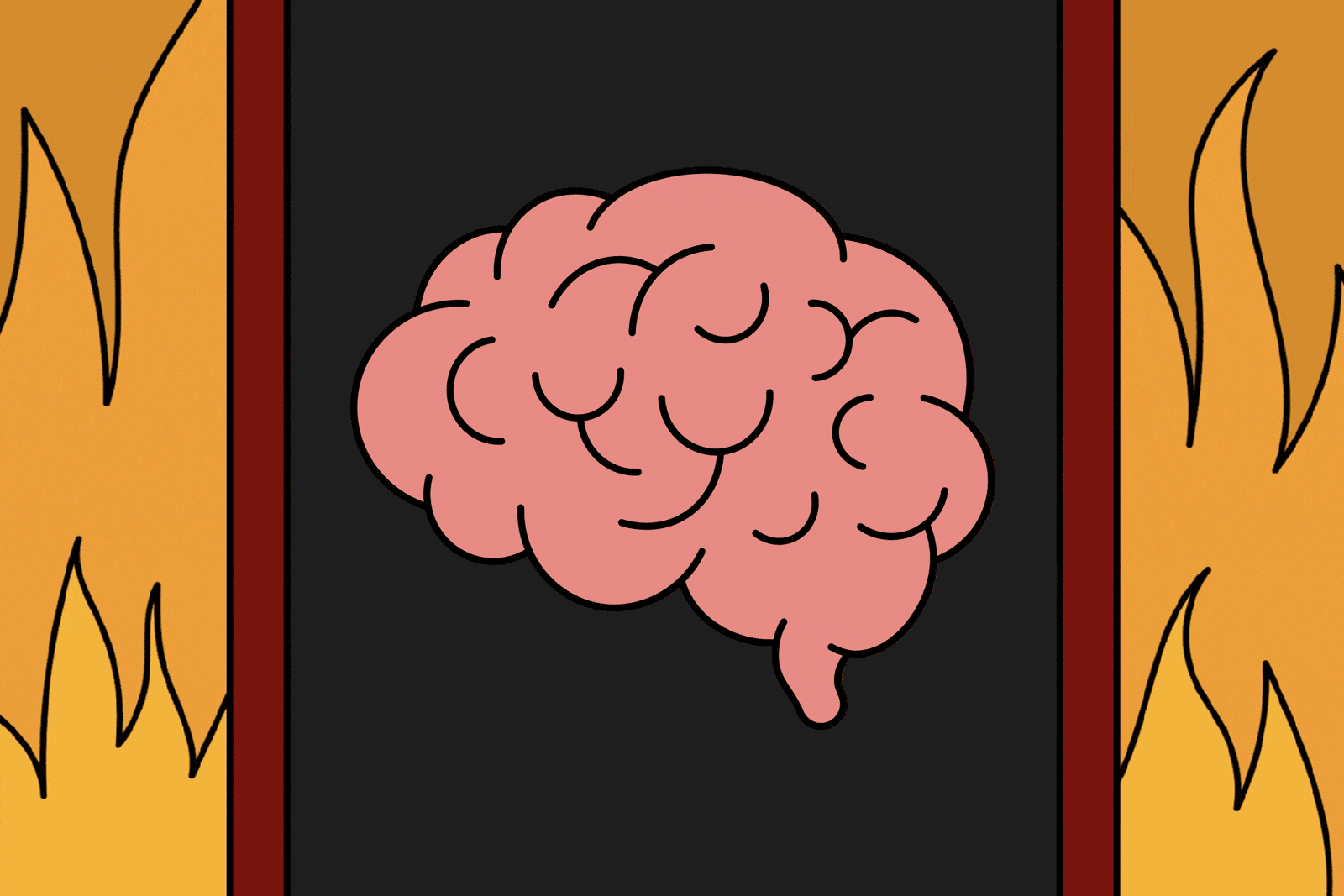What Is “Doomscrolling”—and How Can You Stop the Cycle?
Updated: Jul. 24, 2024

Up late reading bad news on your phone again? Here's how to stop the unhealthy habit of doomscrolling.
Most of us have been there: It’s midnight, and we really should turn off our phones and go to bed, but we can’t stop “doomscrolling” through news apps and social media, reading about the Ukraine-Russia war, soaring gas prices, inflation, racial injustice, climate change, or all of the above. We also can’t help wondering, “Is the pandemic over?” and reading news stories about the latest COVID-19 variants. There’s no doubt the past few years have been a doozy, leading to a dramatic increase in the use of Facebook, Twitter, and media sites. But why do we insist on doomscrolling when it makes us feel so bad?
“Many who experience these scrolling behaviors find there’s an urgency to look, learn, and understand the sensational issues going on in the world,” says Deborah Serani, PsyD, a psychologist and professor at Adelphi University in Garden City, New York. “However, the constant hypervigilance we engage in by doomscrolling is exceedingly harmful.”
An obsessive doomscrolling habit is neither helpful for staying informed nor good for our health. A 2022 University of Florida study published in the American Psychological Association journal Technology, Mind, and Behavior found that doomscrolling was linked to anxiety as well as problematic use of the Internet and social media. And a 2020 Dartmouth study found that college students’ amount of phone usage and COVID-19–related news exposure was also associated with greater reports of anxiety and depression.
“There is no question that doomscrolling can be addicting,” says psychologist Sherry Benton, PhD, founder and chief science officer of the online therapy company TAO Connect. Many of us have a cell phone addiction to begin with, and “the more dramatic the news, the more we tend to get lost in it.” Here are a few tips to get over phone addiction.
With bad news always at our fingertips, though, how can we limit our consumption before it becomes unhealthy? We asked the experts for advice.
So, what is doomscrolling?
The word still hasn’t made it into the dictionary, although Merriam-Webster has named it one of the “words we’re watching,” with a definition of “the tendency to continue to surf or scroll through bad news, even though that news is saddening, disheartening, or depressing.” The term first appeared around 2018 but has gained popularity since the tumultuous year of 2020; it can also be called “doomsurfing.”
And although it’s not yet an official psychological behavior, the 2022 University of Florida study found it to be a distinct concept and a new and unique behavior that can be measured. Doomscrolling is not just the search for news but the compulsion to seek out negative information.
It’s not that being informed is bad—for example, there have been some positive changes since the anti-racism protests began—but it’s the constant intake of negative information that’s a problem. “Essentially, this is a consciously focused activity of scrolling from one terrifying story, video, or news coverage to another,” Serani says.
Is doomscrolling a new phenomenon?
Though greater cell phone and tablet use, in addition to Internet access, has fueled the doomscrolling phenomenon and the negative effects of social media, research has shown that exposure to bad news following traumatic events has also been a problem in years past.
One University of California study from 2013 found that exposure to four or more hours a day of early 9/11-related television was linked with a greater incidence of health problems several years later. Another study found that greater media exposure to the Boston Marathon bombings in 2013 was linked with acute stress.
“Doomscrolling doesn’t only take place on your phone or computer,” Serani says. “Remote-scrolling—going from one television station to another during traumatic events—is also a health concern.” With the advent of smartphones, having constant, easy access to bad news has likely just heightened a behavior we already had a tendency to engage in.
Can you blame the media for doomscrolling?
In part, yes. “When media companies profit through advertising and rates related to the number of readers, headlines might be written more dramatically to gain views,” Benton says.
This isn’t new. Writers have used sensationalist headlines to sell newspapers for more than a century. Still, it might be even more true today. “‘News’ is no longer a process of sharing helpful information but rather what researchers are calling ‘attention economy,'” Serani says. “The goal of news today for stories, websites, tweets, posts, and the like is to create viewer traction and user retention” to keep your eyeballs on their site longer.
Plus, social media and news apps have another ace up their sleeves for pulling you in and getting you to keep reading. “The algorithm on sites might also recommend more ‘doom-and-gloom’ articles the more you read them,” Benton says.
Before you know it, your news feed is filled with all the bad happening in the world—and none of the good. You may find that you spend too much time on Facebook reading the negative stories the site keeps shoving in your face.
What causes doomscrolling?

Doomscrolling develops from an almost uncontrollable need to keep on the lookout for threats. “People often seek risky, scary, and negative information because it alerts us to the risks in our environment. It helps us prepare,” Serani says. “People who doomscroll are, indeed, quite upset, but instead of sealing themselves off from the trauma, they actually seek more stimulation from the unnerving issue.”
The clinical term is “counterphobic” behavior, she says: Instead of fleeing from the thing that scares us, we are attracted to it.
“They want to know more. They need to know more. They counter the feelings of anxiety by watching and rewatching,” Serani says. “It becomes a kind of compulsion, to repeat the disturbing news over and over.” Plus, humans don’t like uncertainty, so we keep reading, hoping to figure things out. In doing so, we’re trying to make sense of traumatic events, Serani says.
Our tendency to seek out bad things is actually a primitive behavior; this kind of vigilance kept us ready for trouble. “Detecting danger is a central function of our brain and central nervous system. In our cave-dwelling days, this prevented us from threats related to attacks from animals or people, and from being caught in dangerous weather,” Benton says. “The problem is that our nervous system still works the same in our current day and age and doesn’t discriminate between real threats and the bad news we read about. That bad news can send our bodies into high alert.”
Oddly, humans’ penchant for seeking out and identifying danger can chemically give us a natural high, which is also why people love getting scared. “Humans enjoy the adrenaline rush of fear—it’s why we ride roller coasters and go to haunted houses around Halloween,” Benton says. “We get that same rush when our fear response is triggered reading disturbing material. Thrillers, mysteries, and other adrenaline-triggering books are really popular for a reason.”
Seeking out negative news may also be part of this phenomenon because it gets our blood up: There’s a certain thrill in reading about disaster, like a train wreck we can’t look away from. As a result, people may have a “negativity bias” that draws them to bad news—and sometimes even fake news—which could be the reason for the old journalism adage “If it bleeds, it leads.”
What are the effects of doomscrolling?
If doomscrolling can make us feel good, why is it so bad? “Too much consumption overwhelms our system,” Benton says. “We begin to suffer from stress, anxiety, or depression. Our bodies produce high levels of a natural steroid called cortisol, which can wreak havoc on your body. One might experience things like digestive problems, headaches, sleep problems, memory or concentration impairment, and heart disease. Cortisol and chronic stress can also contribute to weight gain.”
Serani says this heightened state of stress due to doomscrolling keeps us alert at first, pumping us full of adrenaline and orexin, which affect emotional arousal, as well as cortisol. “But then, over time, our body and mind become overtaxed staying so aroused and vigilant,” she says. “So, long-term stress causes our blood pressure to spike, our heart rate to soar. Our muscles tense, our mood changes, and before you know it, we’re tired, fatigued, irritable, and needing a good, long rest from everything and everyone.” We might also experience chronic pain and lowered immunology.
Research, including a 2022 study published in Psychological Trauma and a 2021 study in Perspectives in Psychiatric Care, has shown that doomscrolling is as bad psychologically as it is physically. “Studies have found doomscrolling worsens mental health, deepens insecurity, increases feelings of helplessness, and distorts cognitive bias,” Serani says. Cognitive bias is the way your brain interprets information.
This means exposure to too much bad news can give you a negative outlook on the world around you, even when you’re off-line. “The cumulative exposure to stories of trauma, crisis, fear, and helplessness change our social expectations, making us believe that the world is truly a scary place,” Serani says. “Doomscrolling can make us feel utterly hopeless.”
This can warp our perception of reality. See, even though we’ve faced challenging situations lately, the world isn’t all bad, and all the conspiracy theories out there making it seem even worse are just bunk. “When you read article after article of horrible news, it’s easy and not uncommon to feel like the world is falling apart,” Benton says.
How much doomscrolling is too much?
The exact amount of bad news to take in may depend on the person. One 2020 German study on the effects of COVID-19–related media exposure found seven times per day and two-and-a-half hours to be the tipping point. But that might even be too much for some people. “If you are spending more than an hour or two to stay caught up on the news, that is a sign you probably need to shift your focus to something else,” Benton says.
Beyond a specific time limit, you’ll also want to consider how your news habit is affecting you physically and mentally. “First, take a step back and assess how much time you’re spending on the habit,” Benton says. “Additionally, when you start to have difficulty sleeping, headaches, or digestive problems, that is an important sign to consider changing your media consumption habits.”
You don’t have to quit Facebook, Instagram, Twitter, and TikTok entirely, but you do need to reassess.
How do you stop doomscrolling?
Stopping your bad news habit means setting limits for yourself, as well as your cell phone, social media, and news channel usage. “Statistics report that the average media user is online or watching television over six hours a day,” Serani says. “When it comes to the consumption of media, it’s really important to have structure.” Here’s how you can stop yourself from going down the Internet rabbit hole.
Give yourself a time limit
Instead of aimlessly doomscrolling, be more intentional about your information consumption. “If you feel a need to know what’s going on, give yourself a limit of one hour a day for scrolling current events,” Serani says. “You’ll be informed and have greater well-being with this approach.”
Don’t doomscroll before bed
In addition to how long you’re going to consume news media, plan for when you’re going to do it as well. Starting your day by scrolling through news is likely to be mentally healthier than doomscrolling at night in the dark before bed, which could lead to trouble falling asleep. That’s right: Simply avoiding late-night doomscrolling can actually make you happier. If you do reach for your phone, opt for turning on the iPhone white noise feature, instead.
Manage your notifications
Take advantage of your phone’s settings to better manage the stream of info that pings your phone. It’ll help you keep the boundaries you’ve set and not get sucked back in. “Consider deleting your news media apps or turning off notifications for breaking news,” Serani says. If deleting them seems too drastic, try to simply hide apps on your iPhone to take a break from them. We know it’s not going to be as if social media disappeared, but it’s a start.
Spend time in the real world
Social media can help us feel connected, but too much time on it, especially when it’s negative and unhealthy, can affect our real life. “Take time away from your phone or computer by engaging in non-technology and feeding your senses,” Serani says. “[Try] experiences like exercising, talking with loved ones, cooking, cuddling with a pet, or listening to soothing music.”
Practice self-care
It can feel odd to disconnect when we are so used to being online, but it can help us shift our focus. Benton suggests building a self-care plan of practices including relaxation and mindfulness techniques: When you’re engaging in mindfulness, you’re living in the moment by giving your full attention to friends and family or participating in hobbies and activities you enjoy.
Shift the media you consume
When you are online, try to balance your intake of the negative with the positive. You might feel guilty searching out something whimsical instead of the more crucial news of the world, but it’s important for your health to find good news stories too. “If you have to do a search for information, consider ‘kindness scrolling,’ which has been shown to be meaningful,” Serani says.
In a 2021 study published in the journal PLOS One, exposure to COVID-19–related kind acts did not lead to the same negative emotional consequences as bad COVID-19–related news. Likewise, reading heartwarming stories about Ukrainian refugees is likely to have a more positive impact on your mental health than binge-reading news only about the devastations of the war.
“The idea of searching for good news is a brilliant way of inoculating yourself against doomscrolling,” Serani says. “Taking in media that contains positive, meaningful, and pro-social events reduces anxiety, sadness, and feelings of hopelessness, be it a human interest story, an uplifting video, or even something silly, like tiny goats dressed in sweaters jumping and playing—my upbeat find for today!”
Consider the source
Learn what’s misinformation vs. disinformation, and make sure your news sources are not peddling either. “The disinformation and misinformation that can be found everywhere online dilute the scientific facts of life as we know it,” Serani says. Even within mainstream news sites, “stories are created to grab you, keep you, and endlessly worry you. Once you learn this, it may help you break your doomscrolling and news-cycling habits.”
Alter your algorithms
There’s a happy side effect of searching out positive stories: It might inadvertently help your news feed become more balanced. “When I was shopping for a new puppy a couple of years ago, I noticed my news feed started to fill with cute puppies. When I was renovating a room in my house, I started to get stories in Architectural Digest and other decorating magazines,” Benton says. “My interests and searches were shifting my algorithms and diversifying the articles suggested.”
Beat social media at its own game by altering your feed to include a better mix of stories. “We can easily modify our news feeds intentionally. Search terms that are interesting to you rather than stressful,” she says. Those might be hobbies, travel stories, the funniest animal stories, or anything you find pleasant, she says.
Look on the bright side
When you’re off-line, lighten things up by watching comedy shows or reading the funniest books you can get your hands on. By mixing it up, you can have a more balanced, positive, and maybe even hopeful view of the world.
Sources:
- Deborah Serani, PsyD, psychologist and professor at Adelphi University in Garden City, New York
- Sherry Benton, PhD, founder and chief science officer of TAO Connect
- Technology, Mind, and Behavior: “The Dark at the End of the Tunnel: Doomscrolling on Social Media Newsfeeds”
- Journal of Medical Internet Research: “Mental Health and Behavior of College Students During the Early Phases of the COVID-19 Pandemic: Longitudinal Smartphone and Ecological Momentary Assessment Study”
- Merriam-Webster: “On ‘Doomsurfing’ and ‘Doomscrolling'”
- Psychological Science: “Mental- and Physical-Health Effects of Acute Exposure to Media Images of the September 11, 2001, Attacks and the Iraq War”
- PNAS: “Media’s role in broadcasting acute stress following the Boston Marathon bombings”
- European Archives of Psychiatry and Clinical Neuroscience: “Associations between COVID-19 related media consumption and symptoms of anxiety, depression and COVID-19 related fear in the general population in Germany”
- Psychological Trauma: “Doomscrolling during COVID-19: The negative association between daily social and traditional media consumption and mental health symptoms during the COVID-19 pandemic”
- Perspectives in Psychiatric Care: “Doomsurfing and doomscrolling mediate psychological distress in COVID-19 lockdown: Implications for awareness of cognitive biases”
- Journalism Studies: “Doomscrolling, Monitoring and Avoiding: News Use in COVID-19 Pandemic Lockdown”
- PLOS One: “Brief exposure to social media during the COVID-19 pandemic: Doom-scrolling has negative emotional consequences, but kindness-scrolling does not”





















